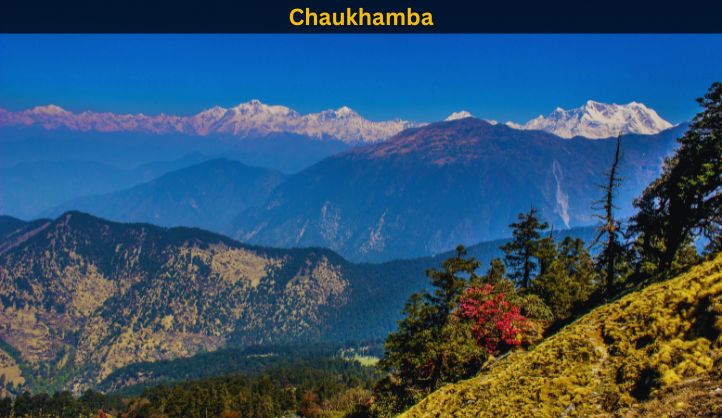Towering over the Gangotri Glacier, Chaukhamba stands as a majestic massif in the Gangotri Group of the Garhwal Himalayas. This captivating mountain range holds a unique position, captivating both trekkers and scholars alike. Its name, translating to “four legs” in Hindi, aptly reflects its quadripartite peak structure, each summit exceeding 7,000 meters. But Chaukhamba’s significance extends far beyond its physical grandeur. It’s a place woven with mythology, a haven for Ayurvedic knowledge, and a challenging objective for mountaineers.
A Mountain Steeped in Myth and Religion
Chaukhamba holds deep significance in Hindu mythology. It’s believed to be the abode of Nar-Narayan, a manifestation of Vishnu, the preserver god. Legends narrate that the four peaks represent the four arms of Nar-Narayan, eternally meditating in the lap of the Himalayas. This association imbues the mountain with an aura of sanctity, attracting pilgrims who undertake arduous treks to reach its base camp.
The reverence for Chaukhamba extends beyond Hinduism. The peak is also revered by the Jain community. They believe it to be the final resting place of Rishabhanatha, the first Jain Tirthankara. This confluence of religious beliefs adds to the mystique surrounding the mountain, making it a revered pilgrimage site for followers of diverse faiths.
How to reach it
By Air
The nearest airport to Chaukhamba is the Jolly Grant Airport in Dehradun, which is well-connected to major cities in India such as Delhi and Mumbai. From Dehradun, you can hire a taxi or take a bus to reach the town of Rishikesh, which serves as a gateway to the Garhwal Himalayas.
By Rail
The nearest major railway station is in Haridwar, which is well-connected to several cities across India. From Haridwar, you can take a taxi or bus to Rishikesh, which is approximately 20 kilometers away.
By Road
Rishikesh serves as the starting point for the journey to Chaukhamba. From Rishikesh, you can hire a taxi or take a bus to reach the town of Joshimath, which is the base for further exploration of the Garhwal Himalayas.
A Treasure Trove of Ayurvedic Knowledge
The name “Chaukhambha” also finds association with Chaukhambha Orientalia, the world’s leading publisher of Ayurvedic texts. Established in Varanasi in the late 19th century, the publishing house has played a pivotal role in preserving and disseminating the ancient Indian medical system. The connection between the mountain and the publishing house, though not directly linked, reflects the deep-rooted connection between the Himalayas and Ayurveda.
Many Ayurvedic herbs, crucial ingredients in traditional medicines, thrive in the high-altitude regions of the Himalayas. The pristine environment and unique climatic conditions contribute to the potency and efficacy of these plants. Chaukhamba, with its towering presence in the Garhwal Himalayas, embodies the very essence of this connection between the mountains and the ancient healing system.
A Challenge for Adventurous Climbers
Beyond its religious and academic significance, Chaukhamba presents a formidable challenge for mountaineers. Its treacherous slopes, extreme weather conditions, and unpredictable crevasses demand exceptional skill and experience. The ascent typically involves traversing glaciers, negotiating crevasses, and tackling challenging ice walls. Only seasoned climbers with proper training and equipment can attempt this demanding peak.
Despite the inherent risks, Chaukhamba attracts experienced mountaineers from across the globe. The sense of accomplishment upon reaching the summit, coupled with the breathtaking panoramic views of the surrounding Himalayan giants, make it a coveted objective for those seeking an adventure unlike any other.
Unveiling the Secrets of Chaukhamba
There are several established routes for climbing Chaukhamba, each presenting unique challenges and rewards. The most popular route ascends via the Gangotri Glacier, offering climbers a chance to witness the sheer scale of this magnificent glacier. The journey begins with a trek to the base camp at Gangotri, followed by technical climbing on the glacier itself.
Another challenging route approaches the peak from the Badrinath Valley. This route involves navigating through dense forests and steep ridges before reaching the base camp. The ascent then progresses over glaciers and icefalls, demanding skilled ice-climbing techniques.
For those seeking a more technical challenge, the Bhagirathi Kharak route offers a direct and strenuous ascent. This route involves tackling steep rock faces and navigating crevasses, pushing climbers to their physical and mental limits.
Regardless of the chosen route, climbing Chaukhamba requires meticulous planning, thorough acclimatization, and a deep respect for the mountain’s inherent dangers.
A Legacy of Exploration and Conservation
The history of climbing Chaukhamba is marked by tales of courage and determination. Early attempts in the 1930s faced several challenges, with the first successful summit recorded in 1939. Since then, the mountain has witnessed numerous expeditions, each pushing the boundaries of human endurance and technical skill.
However, with increased climbing activity comes the responsibility of preserving the pristine environment of the Himalayas. Climbers have a vital role to play in minimizing their ecological footprint. Responsible waste management, respecting local traditions, and promoting sustainable practices are crucial to ensure that Chaukhamba continues to inspire generations to come.
Nearby Places to Explore
Gangotri and Gaumukh
Located at the source of the River Ganges, Gangotri is a holy town revered by Hindus. A dip in the icy cold water of the Ganges is believed to wash away sins. A further 19 kilometers from Gangotri lies Gaumukh, the actual source of the Ganges, emerging from a glacier.
Badrinath
One of the Char Dhams (four abodes) in Hinduism, Badrinath is a revered pilgrimage site. The temple dedicated to Lord Vishnu is a marvel of architecture and a must-visit for those seeking a spiritual experience.
Govind Ghat
A picturesque town serving as the base camp for the pilgrimage to Badrinath. Surrounded by snow-capped peaks and offering stunning views of the Himalayas, Govind Ghat is a popular stopover for trekkers and pilgrims alike.
Valley of Flowers
UNESCO World Heritage Site, the Valley of Flowers is a riot of colors during the monsoon season. Endemic alpine flowers carpet the meadows, creating a breathtaking spectacle.
Hemkund Sahib
A revered Sikh pilgrimage site located near the Valley of Flowers, Hemkund Sahib is a Gurudwara perched amidst stunning mountain scenery. The serene atmosphere and breathtaking views make it a worthwhile detour.
Conclusion
Chaukhamba transcends the boundaries of a mere mountain. It’s a symbol of religious reverence, a repository of ancient knowledge, and a playground for adventurous spirits. Its towering presence serves as a constant reminder of the power and grandeur of nature, while its slopes echo the stories of pilgrims, scholars, and mountaineers.
FAQs about Chaukhamba
1. What is Chaukhamba?
Chaukhamba is a group of four majestic peaks located in the Garhwal region of Uttarakhand, India. These peaks, named Chaukhamba I, II, III, and IV, are part of the Gangotri Group of mountains in the Indian Himalayas.
2. How tall is Chaukhamba?
Chaukhamba I, the tallest peak in the group, has an elevation of 7,138 meters (23,419 feet) above sea level, making it one of the highest peaks in India.
3. How can I reach Chaukhamba?
The journey to Chaukhamba typically begins by traveling to Rishikesh, Uttarakhand, either by air, rail, or road. From Rishikesh, you can proceed to the town of Joshimath and then further to Govindghat. The trek to Chaukhamba usually starts from Govindghat, passing through Ghangaria and the Valley of Flowers.
4. What is the best time to visit Chaukhamba?
The best time to visit Chaukhamba is during the summer months, from May to June, and the post-monsoon season, from September to October. During these periods, the weather is relatively stable, and the trekking routes are accessible. However, weather conditions can be unpredictable in the Himalayas, so it’s essential to check the forecast before planning your trip.
5. Is a permit required to trek to Chaukhamba?
Yes, a permit is usually required for trekking in the area, especially if you plan to visit protected areas like the Valley of Flowers National Park. Permits can be obtained from the forest department or relevant authorities in Uttarakhand.





